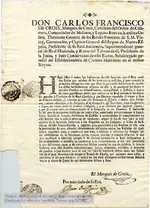Dear Ritchie;
You asked me:
Dear Lamar,
In all the years I have been following the story about the stone maps and the possibility of the Jesuits having made them. I have never seen anyone speak with such authority about the Jesuits as you have. I am more than a little impressed with your knowledge on the subject and your patience with those less knowledgeable. In reading your posts I keep getting the feeling you know something about the Jesuits and the possibility that they may have been mining than you are telling us. I will let that pass for now, but I do have a question for you.
Is it true that the reason for the 1767 expulsion was sealed at the time and remains unknown to this day?
I have read this on the internet in many forums, but never seen any proof that it is true.
If it is not true, could you briefly explain what the reason was for the expulsion?
If you know it.
Thank you in advance for your reply,
Ritchie
It's been my experience that there exists very few *sealed* documents in regards to anything with is housed in the Vatican archives or elsewhere within the Roman Catholic church, my friend. If you are referring to the Vatican Secret Archives, then I feel I should tell you now that the title "Vatican Secret Archives" is a direct, and very literal, translation of the official Latin title, which is Archivum Secretum Vaticanum. In this particular case, the word "Secretum" means "Private" or "Restricted" as in "The Pope's Personal Archives", which is what the Vatican Secret Archives are. They are not a part of the Roman Curia, and they are in no way secret, and how could they be if everyone knows about them?
The access to the Vatican Secret Archives is highly restricted and there is a very good reason for this to be so. First, the archives are privately owned and maintained by the Roman Catholic Church, and as such they are not a public library. Next, the Vatican Secret Archives houses the largest collection of documents pretaining to Christianity in the Middle, Near and Far East, and Europe, in existence, along with documents of a scholarly nature and as such, they are priceless. Next, the Vatican Secret Archives actually has very few personel attached to it, as there is a shortage of ordained clergy throughout the Church and virtually all ordained members are being assigned to parish duties. This makes it very difficult to gain access into the archives as there are not enough clergy to assist everyone. In short, there are no *sealed documents* housed within the Vatican Secret Archives, my friend, nor has there ever been.
Now, the Roman Curia, which is the administrative branch of the Vatican, has within it an Office titled the Apostolic Penitentiaria, or the Apostolic Penitentiary in English, and that Office maintains it's own archives and THOSE documents are sealed by the confessional for eternity. The reason why all documents housed in the Apostolic Penetentiary are sealed in because they deal with confessions and pennances, excommunication and absolutions, and indulgences. The Holy office of the Apostolic Penitentiary acts as the Confessor in the Confessor-Penitent role of the Church and the Office is primarily viewed as an Office of Mercy. I have heard it stated that not even the sitting Pope is permitted to view the archives of the Apostolic Penetentiary, however I do not know whether this is true or not, but it would seem to be so, owing to the sacred nature of the Seal of the Confessional.
The Roman Catholic Church takes the Seal of the Confessional very seriously and as such the Vatican goes to great lengths to ensure that the identities of Her penitents remains a closely guarded secret. The Apostolic Penitentiary does not get involved in matters of organizations within the Church, such as the Jesuits or other Orders. Rather, the Apostolic Penitentiary devotes it's time to individual members of the Church, therefore any sins which the Jesuits may have committed would have needed to been addressed on case by case basis. We know this did not occur as there were no excommunications incurred before, during, or after the expulsion of the Jesuits, therefore the Apostolic Penitentiary would have not had reason to get involved and if there was no involvement, then no records of the Jesuits expulsion would exist in the Archives of the Apostolic Penitentiary.
Now, this leaves only one other possibility, my friend. The records of the Jesuits activities in the colonies may have been burned or otherwise destroyed, not by the Jesuits themselves, but by some of the other *overzealous* missionary types who succeeded them. There exists documentation to the effect that many Dominican missionary groups burnt the archives of the Jesuits which were left behind when the Jesuits were expelled and to a much lesser degree, the Franciscans did this as well. In closing, perhaps at one time or other there did exist evidence of Jesuit mining activities in the New World, but if it did exist, unfortunately it has long since been destroyed.
To answer your question in brief, no, there are no sealed documents regarding the Jesuit expulsion and later suppression my friend.
Your friend;
LAMAR








